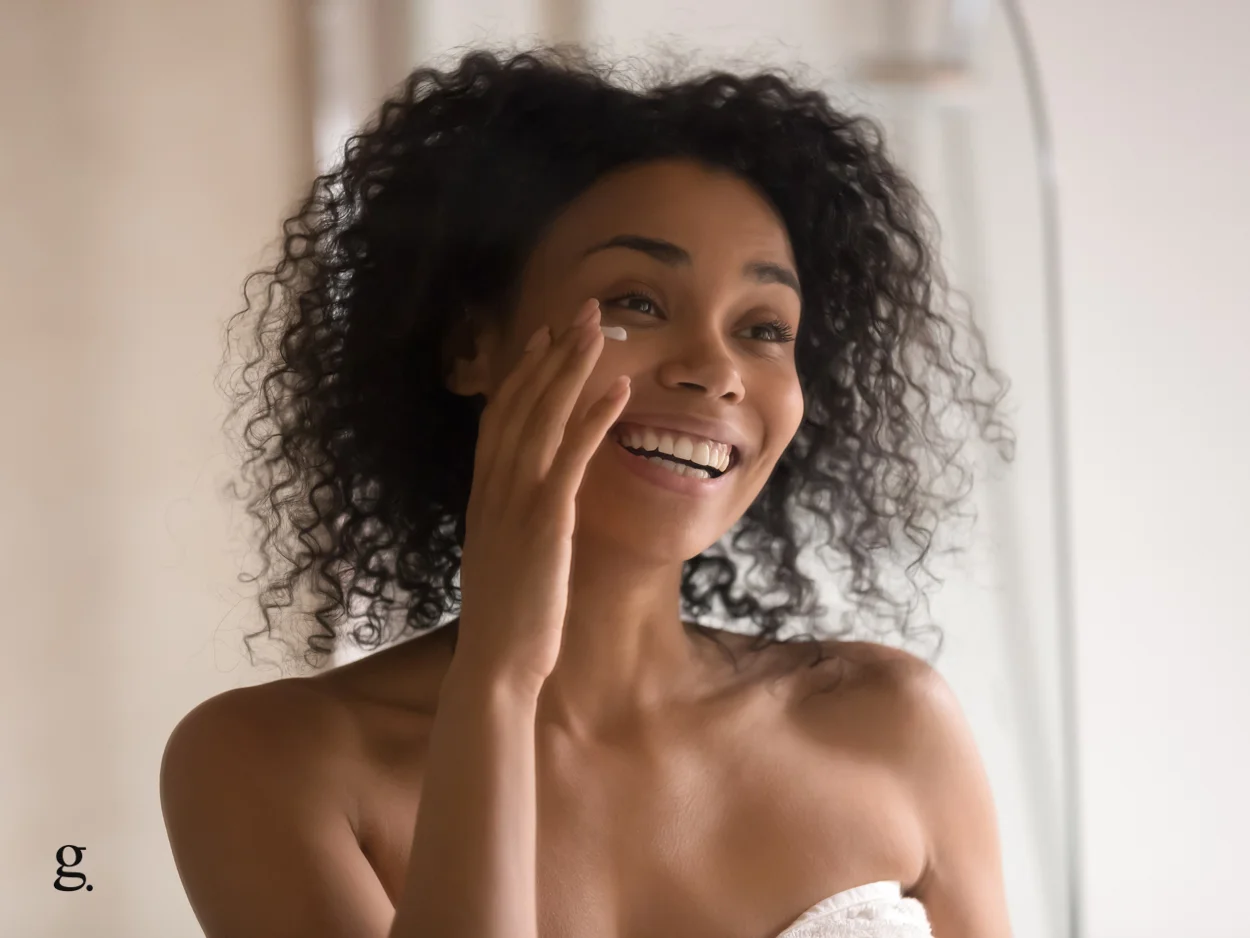Dark circles under the eyes can be a real bummer, right? They often make us look tired, stressed, or even older than we actually are. But don’t you worry, we’ve got your back!
What are “Dark Circles”?
Dark circles, often described as shadows or discoloration under the eyes, can be a real beauty dilemma. But what exactly are they? Let’s take a closer look:
Dark circles are the result of the thin, delicate skin under the eyes revealing the blood vessels and underlying tissue. This area, known as the periorbital region, is more prone to showing signs of fatigue, aging, and dehydration due to its delicate nature.
There are two primary types of dark circles:
- Pigmented dark circles: These are characterized by increased melanin production, causing the skin under the eyes to appear darker. Excess melanin can result from genetics, sun exposure, or inflammation.
- Vascular dark circles: These are caused by the visibility of blood vessels beneath the thin under-eye skin. Factors like sleep deprivation, dehydration, and aging can make the blood vessels more prominent, leading to a bluish or purplish hue.
Now let’s take a look at the best ways to get rid of them…
1. Catch some Zzz’s
Quality sleep is essential for overall health and for reducing under-eye circles. To establish a bedtime routine, try winding down with relaxing activities like reading, journaling, or taking a warm bath. Limit exposure to screens before bed, as the blue light emitted from devices, can interfere with your sleep cycle.
Create a sleep-friendly environment by keeping your bedroom cool, dark, and quiet. Investing in a comfortable mattress and pillows can also help improve your sleep quality. Remember, consistent, quality sleep can work wonders for your appearance and well-being.
2. Stay hydrated
Hydration is key to maintaining healthy skin and minimizing dark circles. Aim to drink at least 8 cups of water per day or more, depending on your activity level and climate. Incorporate hydrating skincare products into your routine, such as serums and moisturizers with hyaluronic acid or glycerin. These ingredients help your skin retain moisture and stay plump, reducing the appearance of dark circles.
3. Apply cold compresses
Cold compresses, chilled teaspoons, or even cold cucumber slices can provide relief for tired and puffy eyes. The cold temperature constricts blood vessels, reducing inflammation and minimizing puffiness. To use a cold compress, wrap ice or a cold gel pack in a soft cloth and place it on your under-eye area for 10-15 minutes, taking care not to press too hard or use anything too cold directly on the skin.
4. Treat your allergies
Allergies can be a major contributor to dark circles. Consult a doctor to identify potential allergens and receive appropriate treatment. Over-the-counter antihistamines, prescribed medication, or allergy shots can help manage your symptoms. Avoid rubbing your eyes, as this can cause further irritation and darkening.
5. Use sunscreen and protective eyewear
Sun protection is crucial for preventing dark circles and maintaining youthful skin. Apply a broad-spectrum sunscreen with at least SPF 30 to your face, including the under-eye area. Wear sunglasses with UV protection to shield your eyes from harmful rays, which can cause melanin production and collagen breakdown.
6. Incorporate a retinol cream
Retinol, a form of vitamin A, is a powerful skincare ingredient that boosts collagen production and thickens the skin. Introduce a retinol-based eye cream into your routine slowly, starting with a low concentration and using it every other night to minimize potential irritation. Remember to apply sunscreen during the day, as retinol can make your skin more sensitive to the sun.
7. Opt for a brightening eye cream
Choose an eye cream with ingredients like vitamin C, niacinamide, caffeine, or arnica to improve circulation, brighten the skin, and reduce dark circles. Consistent use of targeted eye cream can help diminish the appearance of dark circles over time.
8. Under-eye patches
Under-eye patches are specifically designed to target the delicate skin around the eyes, providing much-needed hydration and nourishment. These patches often contain potent ingredients such as hyaluronic acid for intense hydration, green tea for its antioxidant properties, and peptides to stimulate collagen production.
For best results, apply the patches to clean, dry skin and leave them on for 15-20 minutes, allowing the active ingredients to penetrate deeply. Regular use of under-eye patches can help reduce puffiness, minimize fine lines, and brighten the appearance of dark circles.
9. Adopt a healthy diet
A healthy diet plays a crucial role in maintaining radiant and youthful-looking skin. To help reduce the appearance of dark circles, focus on consuming foods rich in antioxidants, vitamins, and minerals. Incorporate leafy greens, berries, citrus fruits, and lean proteins into your meals, as these foods are high in vitamin K, vitamin C, and iron.
These nutrients support healthy blood vessels, promote collagen production, and minimize inflammation, all of which contribute to a reduction in dark circles.
10. Limit alcohol and caffeine
Excessive alcohol and caffeine consumption can lead to dehydration, which can worsen the appearance of dark circles. Additionally, both substances can interfere with the quality of your sleep, another factor contributing to under-eye discoloration.
To reduce the negative impact of alcohol and caffeine on your skin, practice moderation in consumption and make an effort to replace these beverages with healthier alternatives like water or herbal teas. Staying well-hydrated and getting adequate rest will help improve the overall appearance of your skin, including the under-eye area.
11. Facial massage and eye exercises
Regular facial massages and eye exercises can help alleviate dark circles by boosting circulation and relaxing the muscles around the eyes. To perform a gentle massage, use your ring fingers to apply light pressure and make small, circular motions around the eye area.
This helps stimulate blood flow and lymphatic drainage, which can reduce puffiness and dark circles. Additionally, eye exercises, such as looking up and down or side to side, can help relax tense eye muscles and improve circulation.
The main causes of dark under-eye circles
Before we tackle the solutions, it’s essential to get down to the nitty-gritty of what causes those stubborn under-eye circles. While some factors may be beyond your control, knowing the causes can help you make better choices to keep your peepers looking fresh and bright.
Here are the main culprits:
- Genetics: Like many other traits, dark circles can be passed down through generations. Some folks are simply born with thinner skin or increased pigmentation under the eyes. If most of your family members have dark circles, genetics are likely playing a role in yours too.
- Aging: Father Time waits for no one, and as we grow older, our skin loses collagen and elasticity. This natural thinning of the skin can make the underlying blood vessels more noticeable, contributing to the appearance of dark circles. Additionally, the fat pads under the eyes can shift with age, creating hollows that can cast shadows.
- Sleep deprivation: Beauty sleep is a real thing! Skipping that precious Zzzs can have a huge impact on your under-eye area. When you don’t get enough rest, blood vessels under the eyes dilate, leading to darker circles and puffiness. Plus, sleep deprivation can cause cortisol levels to rise, which can break down collagen and make the skin thinner.
- Dehydration: Not getting enough H2O can leave your body and skin thirsty for hydration. Dehydration can cause your skin to look dull and lifeless, making dark circles more pronounced. Drinking plenty of water and using hydrating skincare products can help keep your skin looking plump and healthy.
- Allergies: Pesky allergies can lead to itchy, watery eyes. Rubbing your eyes can damage the delicate skin and blood vessels around them, causing inflammation, redness, and darkening. Additionally, allergens can cause your body to release histamine, which can dilate blood vessels and make dark circles more prominent.
- Sun exposure: Spending too much time under the sun without protection can cause increased melanin production, which can darken the skin around your eyes. UV radiation also breaks down collagen and elastin in the skin, worsening the appearance of dark circles.
Conclusion
Dark circles under the eyes can be caused by various factors such as genetics, aging, sleep deprivation, dehydration, allergies, and sun exposure. To combat these pesky dark circles, adopt a comprehensive approach that includes getting quality sleep, staying hydrated, using cold compresses, treating allergies, protecting your skin from the sun, and incorporating targeted skincare products.
Additionally, maintaining a healthy diet, limiting alcohol and caffeine, and practicing facial massages and eye exercises can further help reduce the appearance of dark circles, leaving your under-eye area looking fresh and rejuvenated.

